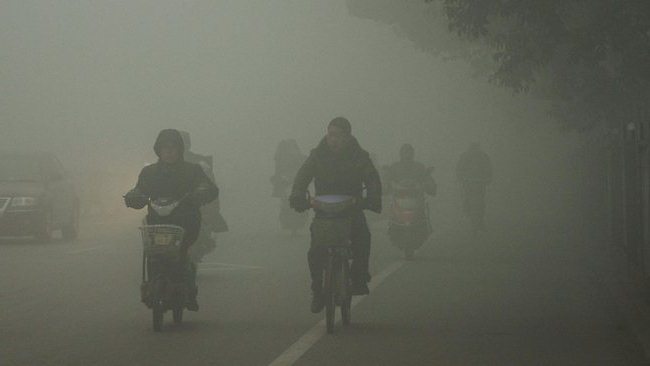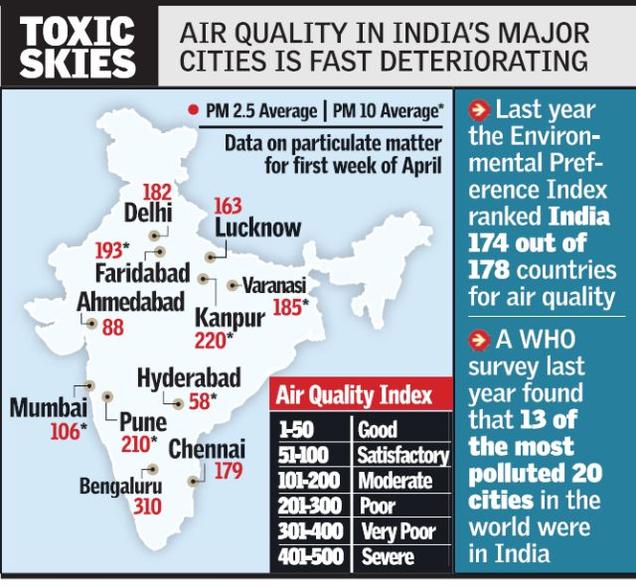Air Quality Index
The Air Quality Index (AQI) is a numerical scale that provides a simplified and standardized representation of the current air quality and its potential health impacts based on concentrations of key air pollutants.
In other words, Air Quality index (AQI) is method of making easy to understand comparison of Air quality numbers for different regions. Today Environmental pollution has become serious issue. Similarly it has also become need to spread the awareness about pollution by publishing pollutants present in environment for particular cities. But normally air pollution is defined in numbers of pollutants present in air with their quantities or concentrations. This should be done in simpler way as layman may not understand the numbers and technical terms provided by authorities. So there is a need of indexing concentrations of major parameters with a number which will give an idea to citizens in non-technical way.
What do we mean by Air Quality and how it is measured?
What is Air quality Index (AQI)?
Air quality index (AQI) or Air Pollution Index can be defined as weighted average of Environmental Pollutants concentrations with air quality standards allowed by Pollution control board. In simple way we can say that it’s a relative numbers as compared to Air quality standards defined by pollution control board. it can be measured by Environmental Monitoring
It provides a numerical value that indicates the overall air quality and the potential health impacts associated with different levels of air pollution. The AQI is a helpful tool for governments, environmental agencies, and the public to understand the current air quality status and take appropriate actions to protect health and the environment.

Air quality Index Parameters
In day to day life Suspended Particulate Matters (SPM), Sulphur Dioxide (SO2), Carbon Monoxide (CO), Oxides of Nitrogen (NOX) and Ozone (O3) are considered harmful to human health. Air quality index or Air Pollution Index can go up if wind speed is low, sudden rise in temperature because air pollutants remain in area without getting diluted. Many countries have notified to public to use public transportation if there is rise in AQI. It can be made easier to understand by plotting wind rose with available data.
Uses of Air pollution Indices
- It helps in creating awareness in citizens about air quality
- It also helps in comparing air qualities of different cities
- Data can be used for development of system to avoid pollution or management of air pollution
Read more About & Indoor air quality standards
Types of Air Quality Indices
There are two types of Air quality indices depending upon their purposes.
- Short-term Air quality indices: Short term indices can provide data for public on daily level.
- Long-term Air quality Indices: Long-term indices are intended to examine change over period of several years. These indices can be very helpful to understand trends in Air pollution and also gives an idea of effectiveness current enforcement policies.
Air Pollution Index Calculation
There are several Methods available to determine Air Quality Index. We will see only some of the important methods in AQI Calculation.
- In First method, addition of percentages of all parameters with their standards.
- In second method, Average of Percentages of all parameters with their standards
- In third method, Addition of Air quality index is calculated for each parameters based on their level of presence
- In Fourth method, this is maximum type method. Only one pollutant based on its Index, which is highest is reported
- In Fifth Method, Only Sulphur Dioxide and Particulate matters are taken into consideration to calculate Air Pollution index
- In Sixth method, only one major pollutant is reported.
Each method has its own advantages and disadvantages. Also research and development is going on to create scientifically defensible method to calculate Air quality method. Also the major focus of that method is to calculate effects of Pollutants on Human health, Animals and Plants etc.
Rating scales for Indices
| Air Quality Index Value | Remarks | Colour |
| 0-25 | Clean Air | Green |
| 26-50 | Light Air Pollution | Yellow |
| 51-75 | Moderate Air Pollution | Orange |
| 76-100 | Heavy Air Pollution | Red |
| 101-300 | Severe Air Pollution | Purple |
| >300 | Hazardous | Maroon |
The AQI is typically calculated based on the concentration levels of specific air pollutants, including particulate matter (PM2.5 and PM10), ozone (O3), nitrogen dioxide (NO2), sulfur dioxide (SO2), and carbon monoxide (CO). Each of these pollutants has its own air quality index scale, and the overall AQI is determined by the highest index value among these pollutants.
For each pollutant, concentration levels are mapped to corresponding AQI categories, usually ranging from “Good” to “Hazardous.” These categories represent different levels of health risks associated with exposure to the pollutants. The AQI scale may differ slightly from country to country, but the general concept remains consistent.
Understanding AQI Categories:
- Good (0-50): Air quality is considered satisfactory, and air pollution poses little or no risk.
- Moderate (51-100): Air quality is acceptable; however, there may be a risk for some individuals, particularly those with respiratory conditions.
- Unhealthy for Sensitive Groups (101-150): People with respiratory or heart conditions, children, and the elderly may experience health effects. General public usually not affected.
- Unhealthy (151-200): Everyone may begin to experience health effects; members of sensitive groups may experience more severe health issues.
- Very Unhealthy (201-300): Health alert! The entire population is likely to be affected, and serious health effects may occur.
- Hazardous (301-500): Health warnings of emergency conditions. The entire population is at risk of severe health effects.
Display Indices for Public
Many Countries (Including India) show/publish city wise air quality indices via newspapers, websites, radio, real-time at certain locations and televisions.

To Summarize, It is better to have single methodology to express Air Pollution index for one country, so that it becomes easy to take decisions based on Indices. So All pollution control boards of a country should set one procedure to calculate air Quality indices.
The Impact of AQI on Health
Air pollution, as indicated by AQI, can have a significant impact on public health. Short-term exposure to high AQI levels is associated with a range of health problems, including respiratory issues, aggravation of pre-existing conditions such as asthma and chronic obstructive pulmonary disease (COPD), cardiovascular problems, and even premature death. Long-term exposure to poor air quality is linked to chronic respiratory and cardiovascular diseases, reduced lung function, and an increased risk of developing conditions like lung cancer.
Children, the elderly, pregnant women, and individuals with pre-existing health conditions are more vulnerable to the health effects of air pollution, making it crucial to be aware of the AQI and take appropriate precautions during periods of elevated pollution levels.
Learn More about How to Improve Air Quality
Using AQI to Protect Health:
AQI information is typically made available to the public through various platforms, including government websites, weather apps, and air quality monitoring stations. Health advisories are issued when AQI levels reach unhealthy or hazardous ranges, urging people to take preventive measures.
During days of high AQI, it is advisable to limit outdoor physical activities, especially for sensitive groups. Staying indoors with proper ventilation, using air purifiers, and avoiding exposure to indoor sources of pollution can help reduce the impact of poor air quality on health. Additionally, reducing personal emissions, such as using public transportation or carpooling, can contribute to improving overall air quality.
How indoor air quality is monitored?
Final Thought on Air Quality Index
The Air Quality Index (AQI) serves as a vital tool in assessing and understanding air pollution levels and their potential impacts on health. By providing a standardized and easily understandable scale, the AQI helps raise public awareness about air quality, encourages timely preventive actions, and fosters a collective effort to reduce pollution and protect human health and the environment. Governments, environmental agencies, and individuals alike should actively participate in efforts to improve air quality, adopting sustainable practices and policies to create a cleaner and healthier living environment for current and future generations.

I want to know what’s the standard method for determind %SOx, %NOx, %O3, COx; that you use.
Thanks
Thanks for your reply.
We use Below standard methods:
for SOx: Improved West & Gaeke
for NOx: Modified Jacob & Hochheiser
For O3: OSHA
for COx: Instrumental Method.
Let me know if you have any other doubts.
This gives good piece of valuable information and an eye opener for the public.